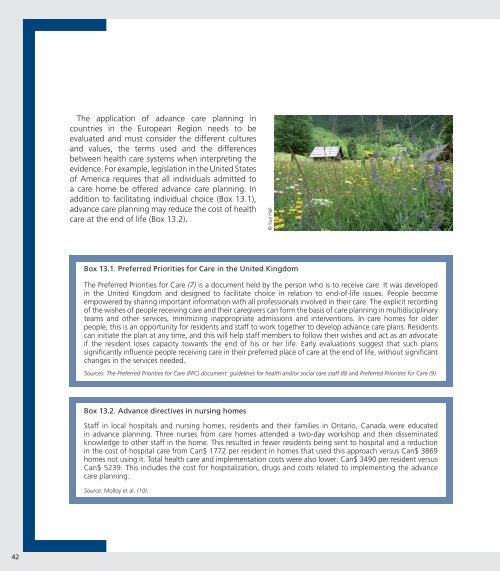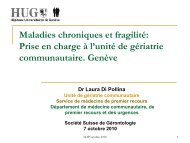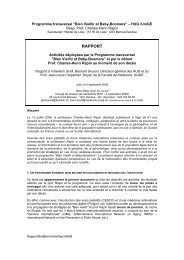Palliative care for older people - World Health Organization ...
Palliative care for older people - World Health Organization ...
Palliative care for older people - World Health Organization ...
You also want an ePaper? Increase the reach of your titles
YUMPU automatically turns print PDFs into web optimized ePapers that Google loves.
The application of advance <strong>care</strong> planning incountries in the European Region needs to beevaluated and must consider the different culturesand values, the terms used and the differencesbetween health <strong>care</strong> systems when interpreting theevidence. For example, legislation in the United Statesof America requires that all individuals admitted toa <strong>care</strong> home be offered advance <strong>care</strong> planning. Inaddition to facilitating individual choice (Box 13.1),advance <strong>care</strong> planning may reduce the cost of health<strong>care</strong> at the end of life (Box 13.2).© Sue HallBox 13.1. Preferred Priorities <strong>for</strong> Care in the United KingdomThe Preferred Priorities <strong>for</strong> Care (7) is a document held by the person who is to receive <strong>care</strong>. It was developedin the United Kingdom and designed to facilitate choice in relation to end-of-life issues. People becomeempowered by sharing important in<strong>for</strong>mation with all professionals involved in their <strong>care</strong>. The explicit recordingof the wishes of <strong>people</strong> receiving <strong>care</strong> and their <strong>care</strong>givers can <strong>for</strong>m the basis of <strong>care</strong> planning in multidisciplinaryteams and other services, minimizing inappropriate admissions and interventions. In <strong>care</strong> homes <strong>for</strong> <strong>older</strong><strong>people</strong>, this is an opportunity <strong>for</strong> residents and staff to work together to develop advance <strong>care</strong> plans. Residentscan initiate the plan at any time, and this will help staff members to follow their wishes and act as an advocateif the resident loses capacity towards the end of his or her life. Early evaluations suggest that such planssignificantly influence <strong>people</strong> receiving <strong>care</strong> in their preferred place of <strong>care</strong> at the end of life, without significantchanges in the services needed.Sources: The Preferred Priorities <strong>for</strong> Care (PPC) document: guidelines <strong>for</strong> health and/or social <strong>care</strong> staff (8) and Preferred Priorities <strong>for</strong> Care (9).Box 13.2. Advance directives in nursing homesStaff in local hospitals and nursing homes, residents and their families in Ontario, Canada were educatedin advance planning. Three nurses from <strong>care</strong> homes attended a two-day workshop and then disseminatedknowledge to other staff in the home. This resulted in fewer residents being sent to hospital and a reductionin the cost of hospital <strong>care</strong> from Can$ 1772 per resident in homes that used this approach versus Can$ 3869homes not using it. Total health <strong>care</strong> and implementation costs were also lower: Can$ 3490 per resident versusCan$ 5239. This includes the cost <strong>for</strong> hospitalization, drugs and costs related to implementing the advance<strong>care</strong> planning.Source: Molloy et al. (10).42
















